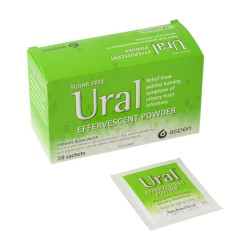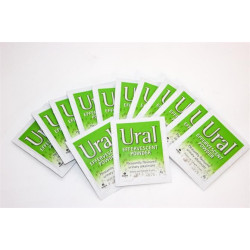Ural Urinary Alkalinizer
Painful, burning sensation when you try to pass urine?
You are not alone, 1 in 2 women may experience a urinary tract infection (UTI), such as cystitis, at some point in their life. Anyone can get a UTI but they are more commonly found in women.
Cystitis is a type of UTI where the bladder becomes inflamed or irritated causing pain and discomfort.
Is it cystitis or UTI? Unless you’re medically trained this may not be the first question you ask yourself when rushing back to the toilet for another painful experience. We all come across complicated sounding medical terms from time to time, but do we really know what they mean?
Having a better idea of what cystitis and UTIs are can help explain why you may have those painful symptoms and why different types of self-care may be useful in relieving symptoms or even preventing them reoccurring. It may also help you decide when it’s time to get help.
So, here are some of the basics on UTIs and cystitis – plus a few other terms you may come across along the way.
What is a Urinary Tract Infection (UTI)?
UTI is a general umbrella term used to describe an infection anywhere in the urinary system, most commonly caused by bacterial microorganisms.
The different types of UTI can include cystitis, an infection of the bladder; urethritis, an infection of the urethra; or pyelonephritis, an infection of the kidneys.
These infections in different parts of the urinary system may have different symptoms associated with them, so for example:
With an infection of the urethra (urethritis) you may get a burning sensation when you urinate along with a discharge
When the infection moves up the urethra and reaches the bladder (cystitis) you may begin to feel you need to urinate more frequently (it may become painful too), blood may also start to appear in your urine and you may get pelvic pressure or discomfort in your lower abdomen
Once the infection reaches your kidneys (pyelonephritis) things start to get more serious with high temperatures, chills, nausea, vomiting and pain in your upper back and side along with all the other symptoms – if the UTI reaches this stage it is important to get urgent medical treatment to prevent your kidneys becoming damaged.
Infections of the kidneys or ureters are also sometimes referred to as upper UTIs, while infections of the bladder and urethra are called lower UTIs.
Another condition you may come across is bacteriuria, which means you have bacteria in your urine – your doctor may have asked you for a urine sample so they can test for bacteria and other micro-organisms if they suspect you have a UTI.
What is Cystitis?
Cystitis is an infection of the bladder specifically, and is the most common type of urinary tract infection (UTI). UTIs are a common problem, particularly for women. It’s been estimated that about 1 in 3 women will have a UTI diagnosed by their doctor by the time they are aged 24, and approximately 1 in 2 may have a UTI at some point in their life – the majority of these UTIs involve the lower urinary tract including the bladder and the urethra.
Most of the time this is caused by a bacterial infection, but not always. Other, less common causes include a sensitivity to chemicals in certain products (such as feminine hygiene sprays or bubble baths), reactions to certain medications or treatments or a complication from another illness, for example, diabetes or kidney stones.
About half the cases of bacterial cystitis are mild and will clear-up in a few days. Self-care actions such as drinking lots of water and complete bladder emptying may help flush bacteria out of your system and taking over-the-counter products, such as urinary alkalinizers to make your urine less acidic, may help relieve some of the painful cystitis symptoms. If your symptoms have not improved within 2 days it is best to get them checked by your doctor.
You are not alone, 1 in 2 women may experience a urinary tract infection (UTI), such as cystitis, at some point in their life. Anyone can get a UTI but they are more commonly found in women.
Cystitis is a type of UTI where the bladder becomes inflamed or irritated causing pain and discomfort.
Is it cystitis or UTI? Unless you’re medically trained this may not be the first question you ask yourself when rushing back to the toilet for another painful experience. We all come across complicated sounding medical terms from time to time, but do we really know what they mean?
Having a better idea of what cystitis and UTIs are can help explain why you may have those painful symptoms and why different types of self-care may be useful in relieving symptoms or even preventing them reoccurring. It may also help you decide when it’s time to get help.
So, here are some of the basics on UTIs and cystitis – plus a few other terms you may come across along the way.
What is a Urinary Tract Infection (UTI)?
UTI is a general umbrella term used to describe an infection anywhere in the urinary system, most commonly caused by bacterial microorganisms.
The different types of UTI can include cystitis, an infection of the bladder; urethritis, an infection of the urethra; or pyelonephritis, an infection of the kidneys.
These infections in different parts of the urinary system may have different symptoms associated with them, so for example:
With an infection of the urethra (urethritis) you may get a burning sensation when you urinate along with a discharge
When the infection moves up the urethra and reaches the bladder (cystitis) you may begin to feel you need to urinate more frequently (it may become painful too), blood may also start to appear in your urine and you may get pelvic pressure or discomfort in your lower abdomen
Once the infection reaches your kidneys (pyelonephritis) things start to get more serious with high temperatures, chills, nausea, vomiting and pain in your upper back and side along with all the other symptoms – if the UTI reaches this stage it is important to get urgent medical treatment to prevent your kidneys becoming damaged.
Infections of the kidneys or ureters are also sometimes referred to as upper UTIs, while infections of the bladder and urethra are called lower UTIs.
Another condition you may come across is bacteriuria, which means you have bacteria in your urine – your doctor may have asked you for a urine sample so they can test for bacteria and other micro-organisms if they suspect you have a UTI.
What is Cystitis?
Cystitis is an infection of the bladder specifically, and is the most common type of urinary tract infection (UTI). UTIs are a common problem, particularly for women. It’s been estimated that about 1 in 3 women will have a UTI diagnosed by their doctor by the time they are aged 24, and approximately 1 in 2 may have a UTI at some point in their life – the majority of these UTIs involve the lower urinary tract including the bladder and the urethra.
Most of the time this is caused by a bacterial infection, but not always. Other, less common causes include a sensitivity to chemicals in certain products (such as feminine hygiene sprays or bubble baths), reactions to certain medications or treatments or a complication from another illness, for example, diabetes or kidney stones.
About half the cases of bacterial cystitis are mild and will clear-up in a few days. Self-care actions such as drinking lots of water and complete bladder emptying may help flush bacteria out of your system and taking over-the-counter products, such as urinary alkalinizers to make your urine less acidic, may help relieve some of the painful cystitis symptoms. If your symptoms have not improved within 2 days it is best to get them checked by your doctor.


